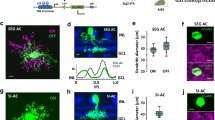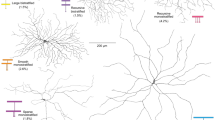Abstract
Ganglion cell receptive fields in the vertebrate retina are classified as ‘simple’ if they display mutually antagonistic, concentric on and off responses to stimulation by light1, or ‘complex’ if they respond maximally to a stimulus which moves in a certain direction or has a particular orientation2. One complex unit frequently reported is directionally selective3–6. It is excited by stimuli moving through its receptive field in only one direction, the preferred direction, and is inhibited by motion in the reverse or null direction. In species such as cats and monkeys which have a predominantly simple centre-surround organization of ganglion cell receptive fields, there is a low ratio of conventional (amacrine cell) to ribbon (bipolar cell) synapses in the inner plexiform layer, while in species such as pigeons and frogs which have a large percentage of complex ganglion cell receptive fields, there is a high ratio of conventional to ribbon synapses. It is therefore thought that amacrine cells, which are laterally interconnecting neurones in the inner plexiform layer, form the complex ganglion cell receptive field7,8. Although quantitative electron microscopy of the inner plexiform layer has indicated that amacrine cells may form the complex receptive field properties of ganglion cells, it offers no clues to the particular morphology of amacrine cells involved. I have therefore now studied amacrine cells in pigeon retina using Golgi impregnation in both whole-mounted and radially sectioned material to see whether there is a correlation between the morphology of amacrine cells and the receptive fields of ganglion cells. In 30 Golgi-impregnated retinas, I have found many different morphological types of amacrine cell. One of these is so clearly different from all other amacrine cells that it requires the separation of pigeon amacrine cells into two distinct classes, those which lack axons (class I cells) and those which have axons (class II cells).
Similar content being viewed by others
References
Kuffler, S. W. J. Neurophysiol. 16, 37–68 (1953).
Lettvin, J. Y., Maturana, H. R., McCulloch, W. S. & Pitts, W. H. Proc. Instn Radio Engrs Aust. 47, 1940–1951 (1959).
Holden, A. L. J. Physiol., Lond. 270, 253–269 (1977).
Maturana, H. R. 22nd int. Cong. physiol. Sci., Leyden, 170–178 (Excerpta Medica, Amsterdam, 1962).
Maturana, H. R. & Frenk, S. Science 142, 977–979 (1963).
Pearlman, A. L. & Hughes, C. P. J. comp. Neurol. 166, 111–122 (1976).
Dowling, J. E. Proc. R. Soc. B170, 205–228 (1968).
Dubin, M. W. J. comp. Neurol. 140, 479–506 (1970).
Cajal, S. R. (1933) as trans. in The Structure of the Retina (eds Thorpe, S. A. & Glickstein, M.) 76–92 (Thomas, Springfield, Illinois, 1972).
Stell, W. K. in Handbook of Sensory Physiology Vol. VII/2 (Springer, Berlin, 1972).
Wyatt, H. J. & Daw, N. W. J. Neurophysiol. 38, 613–626 (1975).
Author information
Authors and Affiliations
Rights and permissions
About this article
Cite this article
Mariani, A. Association amacrine cells could mediate directional selectivity in pigeon retina. Nature 298, 654–655 (1982). https://doi.org/10.1038/298654a0
Received:
Accepted:
Issue Date:
DOI: https://doi.org/10.1038/298654a0
- Springer Nature Limited
This article is cited by
-
Two types of orientation-sensitive responses of amacrine cells in the mammalian retina
Nature (1991)
-
Long-distance intraretinal connections in birds
Nature (1987)
-
Electron microscopy of glutamate decarboxylase (GAD) immunoreactivity in the inner plexiform layer of the rhesus monkey retina
Journal of Neurocytology (1986)
-
Asymmetry in structure of in termediate and large neurons of frog retinal ganglion layer
Neurophysiology (1986)
-
Influence of amacrine cells on receptive field organization of ganglion cells of the generalized vertebrate cone retina: Electronic simulation
Biological Cybernetics (1984)





